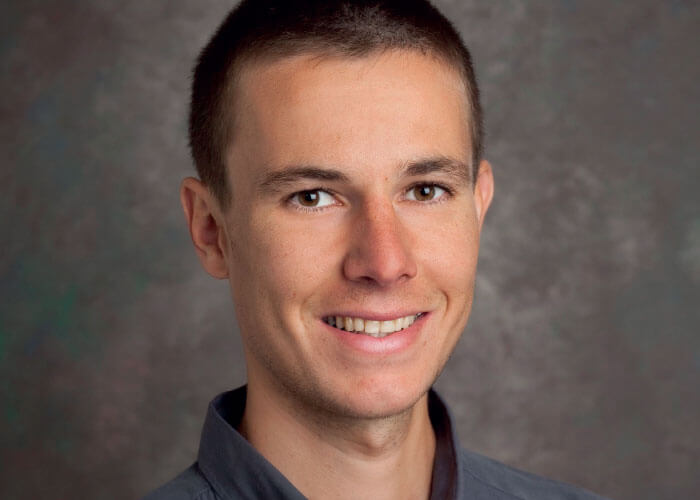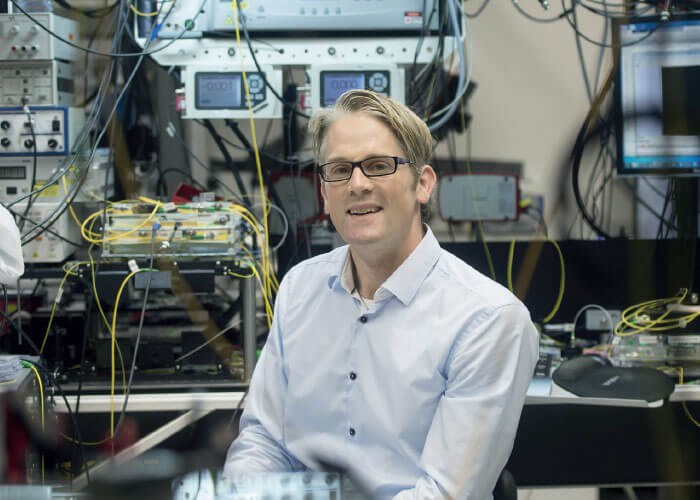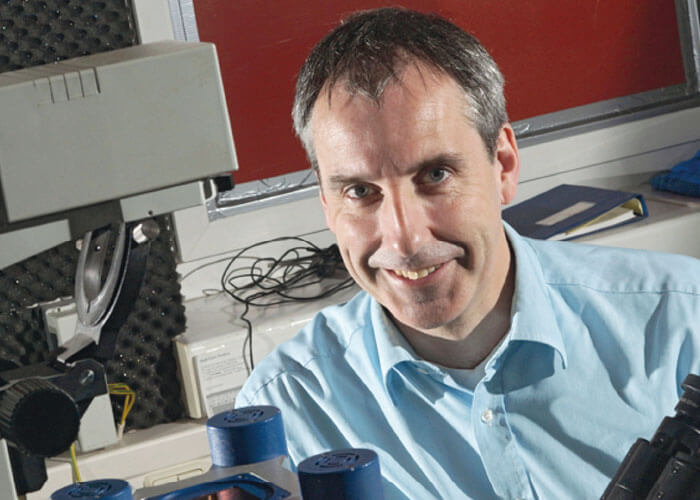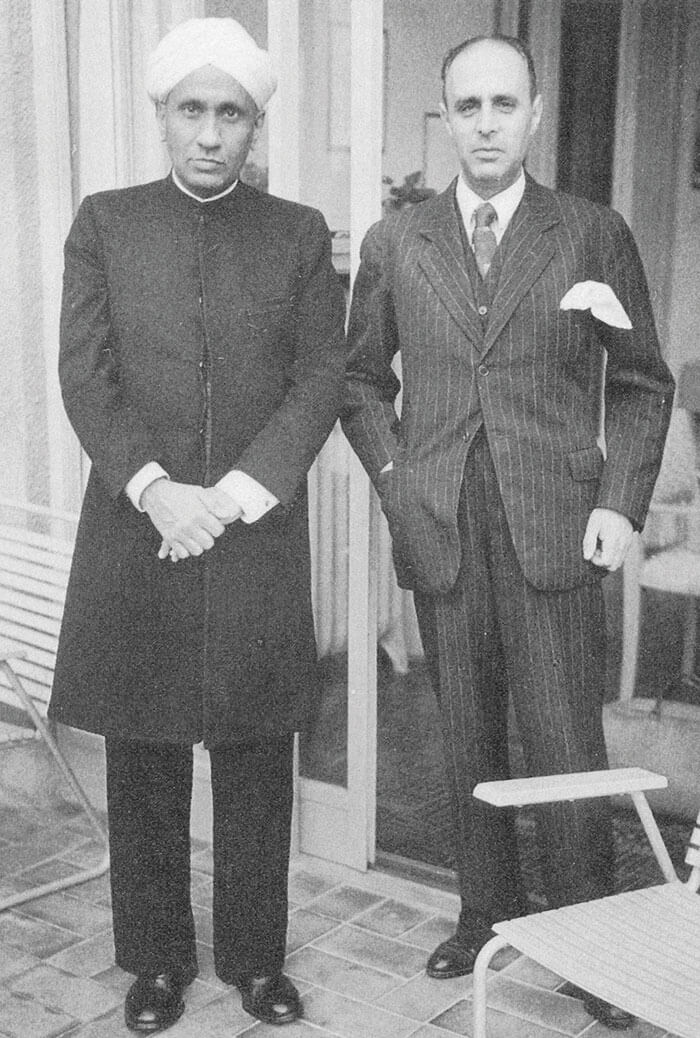The set of vibrational frequencies of a molecule constitutes its unique fingerprint. Vibrational modes that are “Raman-active” interact with incident laser light in an inelastic scattering process. This results in secondary photons with a frequency shifted from the incident ones by the vibrational frequency. Raman spectroscopy leverages this process to optically measure the vibrational spectrum of a molecule (or a material) and thus reveal its chemical identity.
Unfortunately, Raman scattering has a very small cross-section and it is impossible to detect single molecules with a conventionally focused laser beam. A route to overcoming this limitation was discovered in 1997 independently by K. Kneipp et al. and S. Nie and S. R. Emory (2)(3). Using surface-enhanced Raman scattering (SERS), the teams dispersed individual molecules on rough metallic surfaces, which served to focus light down to molecular dimensions. The incident light generates localized oscillating electric fields in the metal, which are called plasmons. With the rapid progress of micro- and nano-fabrication techniques, researchers are now able to tailor the properties of these plasmons in a variety of metallic nanostructures, which has led to rapid improvements in sensitivity and unexpected observations such as nonlinear effects and anomalously large enhancement factors, which could not find explanations within the conventional models of SERS.
Christophe obtained his PhD from Ataç Imamoglu’s group at ETH Zürich (Switzerland) in 2010. He then spent two years as a postdoctoral fellow at Los Alamos National Lab (New Mexico, USA) with Victor Klimov, where he developed a novel spectroscopic technique to study the fluorescence of single nanocrystal quantum dots in an electrochemical cell. In 2012, he joined Michael Hochberg and Tom Baehr-Jones at the University of Delaware (USA) to implement quantum optical devices and experiments with silicon photonic integrated circuits. Since mid-2013, he has been the holder of a fellowship from the Swiss National Science Foundation in Tobias Kippenberg’s group. Christophe’s current research with PhD student Philippe Roelli focuses on the theory and experimental realizations of optomechanical systems based on molecules coupled to plasmonic cavities.

A different angle
Our group has an atypical approach to Raman scattering, since our expertise is not in molecular or crystal spectroscopy but rather in cavity optomechanics. Our field deals with carefully engineered micro-fabricated systems in which a mechanically compliant element modulates the resonance frequency of a high-quality optical cavity. When a laser excites such a system, a Raman process can generate or annihilate one quantum of mechanical excitation (that is to say, a phonon), in analogy to what happens in a molecule or a crystal. Yet the oscillation of optomechanical systems are typically at much lower frequencies and feature much lower damping rates and much longer relaxation times. From our perspective, Raman scattering in optomechanical cavities is thus a tool to manipulate mechanical motion with light. In particular, you can optically damp mechanical oscillations, a technique that has been used in quantum optics to cool trapped atoms or ions to their motional ground state. The work we are doing, therefore, opens a new way to investigate molecular vibrations in the quantum regime using the concepts of quantum optics. In our latest theoretical research, we developed a radically novel framework to model the plasmon-enhanced Raman interaction and calculate the Raman signal. We demonstrate that a vibrating molecule coupled to a localized plasmon is formally equivalent to an optomechanical cavity, a generic system in which a mechanical oscillator modulates the resonance frequency of an optical cavity, consisting of, for example, two facing mirrors. The radiation pressure of photons bouncing on the mirrors can be used to optically amplify their oscillating motion in a process called dynamical backaction amplification (DBA). Our research shows that DBA can be used in SERS to amplify Raman-active molecular vibrations and thus provide a new mechanism for signal enhancement. In other words, light is more than a passive analytical tool; it also acts on the internal molecular degrees of freedom and drives molecular vibrations. The light-induced force, analogous to radiation pressure on a mirror, can thus be used to excite a particular vibrational mode of a molecule well above its thermal motion. The extra excitation greatly enhances the Raman signal, which is proportional to the vibrational energy.Tobias Kippenberg has been a full professor in the Institute of Condensed Matter Physics and Electrical Engineering at EPFL, Switzerland since 2013. Prior to EPFL he was Independent Max Planck Junior Research group leader at the Max Planck Institute of Quantum Optics (MPQ), Garching, Germany, in T. W. Haensch’s laser spectroscopy division. There he demonstrated radiation pressure cooling of optical micro-resonators, and developed techniques with which mechanical oscillators can be cooled, measured and manipulated in the quantum regime that are now part of cavity quantum optomechanics. His group also discovered the generation of optical frequency combs using high Q micro-resonators. Tobias is the recipient of several awards, including the EFTF Award for Young Scientists (2011), the Helmholtz Prize in Metrology (2009), the EPS Fresnel Prize (2009), ICO Award (2014), the Swiss Latsis Prize (2015), the Wilhelmy Klung Research Prize in Physics (2015) and he won first prize in the 8th European Union Contest for Young Scientists in 1996.

The implications?
The practical consequence of our findings is to question some widely accepted guidelines used to optimize the substrates and excitation schemes in SERS. Until now, researchers have obtained large signal enhancement by using broad plasmon resonances, which overlap with both the incoming laser and the outgoing Raman light. Considering DBA, we find two counter-intuitive conditions for obtaining amplification that is even more efficient. First, one should strive for narrower plasmon resonances (more precisely, the width of the resonance should be smaller than the vibrational frequency). Second, the excitation laser should be blue-detuned from the plasmon by exactly the vibrational frequency of the mode to be amplified. Following these new guidelines, researchers and engineers should be able to design and fabricate a new generation of plasmonic devices to push the detection limits of SERS and its analytical capabilities even further. The frequency shift between the laser and the plasmon resonance determines which particular vibrational mode is amplified, which opens a route toward higher resolution spectroscopy and mode-specific amplification. By applying our method, it should be possible to drive one particular vibrational mode far out of thermal equilibrium, and thereby study the dynamics at a molecular scale, quantifying the degree of anharmonicity (deviation of a system from harmonic oscillation) of each mode and their inter-mode couplings. In practice, if the conditions for efficient DBA can be achieved in a commercial device, it would enable very specific detection of given types of molecules by carefully choosing the laser wavelength with respect to the plasmon resonance. Moreover, this parameter is easily tunable, allowing the device to be reconfigured for different molecules. On the detection side, if mode-specific amplification is reached, you could dispense with using high resolution spectrometers to distinguish between different modes, as a single frequency should be amplified and contribute to the signal.Volker Deckert is the head of the “Nano Spectroscopy Group” at the Institute of Physical Chemistry, University of Jena, Germany. The Group’s research goal is to push the lateral resolution of vibrational spectroscopy. The main tool for related projects is tip-enhanced Raman scattering (TERS). Current research with TERS includes biopolymer sequencing, fundamental reactivity on plasmonic assisted reactions, membranes and membrane proteins (studying the nanoscale composition of membranes with respect to lipid distribution and inclusion of proteins, shedding light on intermolecular and intramolecular interactions of protein structures, and examining the basic mechanism of drug delivery), and fast and efficient diagnostics of viruses to establish an ultra-sensitive technology for the qualitative analysis of different viruses and their specific antibodies.

Volker Deckert is the head of the “Nano Spectroscopy Group” at the Institute of Physical Chemistry, University of Jena, Germany. The Group’s research goal is to push the lateral resolution of vibrational spectroscopy. The main tool for related projects is tip-enhanced Raman scattering (TERS). Current research with TERS includes biopolymer sequencing, fundamental reactivity on plasmonic assisted reactions, membranes and membrane proteins (studying the nanoscale composition of membranes with respect to lipid distribution and inclusion of proteins, shedding light on intermolecular and intramolecular interactions of protein structures, and examining the basic mechanism of drug delivery), and fast and efficient diagnostics of viruses to establish an ultra-sensitive technology for the qualitative analysis of different viruses and their specific antibodies.
Duncan is Research Professor of Chemistry and Director of the Center for Molecular Nanometrology at the University of Strathclyde in Glasgow. He is currently Chair of the Editorial Board of Analyst and will serve in that role until 2018. He has been awarded numerous awards for his research including the RSCs SAC Silver medal (2004), Corday Morgan prize (2009), a Royal Society Wolfson Research Merit award (2010), the Craver Award from the Coblentz Society (2012), Fellows Award from the Society for Applied Spectroscopy (2012) and was elected to the fellowship of the Royal Society of Edinburgh (2008). He is a cofounder and director of Renishaw Diagnostics Ltd (2007) and has filed 15 patents with license deals on most of his portfolio. He completed a PhD in organic chemistry at the University of Edinburgh (1996) and his interests are in developing new diagnostic assays based on nanoparticles and spectroscopy with target molecules including DNA, RNA, proteins and small molecule biomarkers.

Duncan is Research Professor of Chemistry and Director of the Center for Molecular Nanometrology at the University of Strathclyde in Glasgow. He is currently Chair of the Editorial Board of Analyst and will serve in that role until 2018. He has been awarded numerous awards for his research including the RSCs SAC Silver medal (2004), Corday Morgan prize (2009), a Royal Society Wolfson Research Merit award (2010), the Craver Award from the Coblentz Society (2012), Fellows Award from the Society for Applied Spectroscopy (2012) and was elected to the fellowship of the Royal Society of Edinburgh (2008). He is a cofounder and director of Renishaw Diagnostics Ltd (2007) and has filed 15 patents with license deals on most of his portfolio. He completed a PhD in organic chemistry at the University of Edinburgh (1996) and his interests are in developing new diagnostic assays based on nanoparticles and spectroscopy with target molecules including DNA, RNA, proteins and small molecule biomarkers.

References
- P Roelli, C Galland, N Piro and TJ Kippenberg, “Molecular cavity optomechanics as a theory of plasmon-enhanced Raman scattering”, Nat Nanotechnol, 11, 164–169 (2016). DOI:10.1038/nnano.2015.264 K Kneipp et al., “Single molecule detection using surface-enhanced Raman scattering (SERS)”, Phys Rev Lett, 78, 1667–1670 (1997). S Nie, SR Emory, “Probing single molecules and single nanoparticles by surface-enhanced Raman scattering”, Science, 275, 1102–1106 (1997). PMID: 9027306. DI Ellis et al., “Illuminating disease and enlightening biomedicine: Raman spectroscopy as a diagnostic tool”, Analyst, 138, 3871–3884 (2013). PMID: 23722248. X Qian et al, “In vivo tumor targeting and spectroscopic detection with surface-enhanced Raman nanoparticle tags”, Nat Biotechnol, 26, 83–90 (2008). PMID: 18157119. P Matousek et al., “Subsurface probing in diffusely scattering media using spatially offset Raman spectroscopy,” Appl Spectrosc, 59(4), 393–400 (2005). PMID: 15901323. D Graham et al., “Control of enhanced Raman scattering using a DNA-based assembly process of dye-coded nanoparticles,” Nat Nanotechnol, 3(9), 548–51 (2008). PMID: 18772916. S Ostovarpour et al., “Through-space transfer of chiral information mediated by a plasmonic nanomaterial”, Nat Chem, 7(7), 591–6 (2015). PMID: 26100808.




